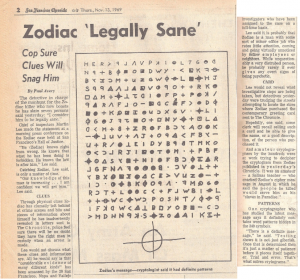Difference between revisions of "Solved 340-character cipher (old version)"
(→Transpositions and other possible variations) |
(→The "Pivots") |
||
| Line 32: | Line 32: | ||
*[http://www.zodiackillerfacts.com/forum/viewtopic.php?p=22455#p22455 Reversible trigram patterns in the intersecting "pivots" of the cipher text] | *[http://www.zodiackillerfacts.com/forum/viewtopic.php?p=22455#p22455 Reversible trigram patterns in the intersecting "pivots" of the cipher text] | ||
*[http://www.zodiackillerfacts.com/forum/viewtopic.php?f=11&t=1282&p=21758#p21758 Experiment to estimate odds of two intersecting "pivots" occurring by chance] | *[http://www.zodiackillerfacts.com/forum/viewtopic.php?f=11&t=1282&p=21758#p21758 Experiment to estimate odds of two intersecting "pivots" occurring by chance] | ||
| − | *[http:// | + | *[http://zodiac-ciphers.dreamhosters.com/wiki/index.php?title=Pivots Experimental results of generating pivots from large collection of plain text] |
== Transpositions and other possible variations == | == Transpositions and other possible variations == | ||
Revision as of 05:49, 3 May 2012
Zodiac, the serial killer who terrorized Northern California in the late 1960s, sent four ciphers to local newspapers. The first cipher was separated into three different parts and each part was sent to Vallejo Times-Herald, the San Francisco Chronicle, and the San Francisco Examiner. The combination of all three parts formed a 408-letter cipher, which was decrypted one week after it was received. Zodiac also sent a 340-letter cipher, mailed on a card on November 8 1969, that remains unsolved to this day.
Contents
Articles and information about the 340 cipher
- Comparison of cipher alphabets
- Comparison of character repetition rates
- Comparison of sequence repetition rates
- Levenshtein distance analysis - A look at the occurrences of repeated sequences that are not exact matches.
- Quadrant analysis - Do the n-gram counts improve If we split the cipher text into four quadrants?
- Quadrant analysis Part 2 - An expansion of the previous quadrant analysis experiment. Is it possible to produce quadrant arrangements that increase the number and quality of homophones detected algorithmically?
- Information theory (entropy, randomness, etc)
- FBI analysis from Dan Olsen
- Cipher-related excerpts from case documents
- Word frequency analysis (word frequencies derived from a corpus of Zodiac correspondences)
- Omnidirectional repetitions - An investigation into patterns that repeat in arbitrary directions by following "snake-like" paths.
- "Complexification" - Did the cipher author begin with a simpler set of cipher symbols, then "complexify" certain symbols to further flatten the symbol distributions?
- Substring ranking - Can we apply measurements that give us a way to find interesting sections of cipher text for focused attacks?
- Catalog of repeating fragments - A comprehensive list of portions of cipher text that occur more than once in the cipher text.
- Cipher Legitimacy - Are the Zodiac ciphers real, or are they hoaxes?
Homophone sequences
- Detection of homophone sequences in the cipher text
- Jurgen Koller's "Two-Times Repetition" approach
- Computation of statistical significance of 6-symbol repetitions at the beginning of the cipher text
- Brute force search for homophone sequences - Shows sequences detected in the 408 and 340 ciphers by performing brute force searches for sequences involving up to 7 symbols.
The "Pivots"
- Reversible trigram patterns in the intersecting "pivots" of the cipher text
- Experiment to estimate odds of two intersecting "pivots" occurring by chance
- Experimental results of generating pivots from large collection of plain text
Transpositions and other possible variations
Is the 340 cipher unsolved because it is not a simple homophonic substitution cipher like the 408 cipher? Here is a collection of considered possibilities:
- Oxcart - Does the 340 cipher's plaintext follow an "ox cart" path; that is, does it read alternately from left to right, then right to left?
- Vigenere
- Playfair
- Bifid
- Many-to-many (one cipher symbol maps to multiple plaintext letters)
- Multiple encryption stages (examples: homophonic that has been rehomophoned, homophonic that has been transposed)
- Phonetic / nomenclator
- Was the cipher intended for use by its author only?
Halloween Card
- Does the Halloween Card, mailed by the killer a year after the 340 cipher, contain clues about the 340?

